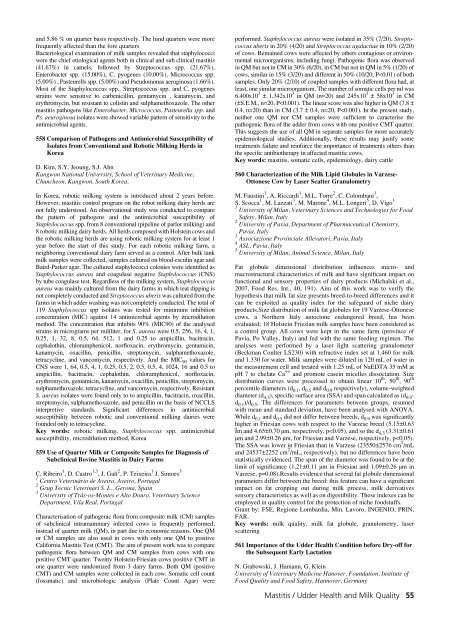Oral and Poster Abstracts
Oral and Poster Abstracts
Oral and Poster Abstracts
You also want an ePaper? Increase the reach of your titles
YUMPU automatically turns print PDFs into web optimized ePapers that Google loves.
<strong>and</strong> 5.86 % on quarter basis respectively. The hind quarters were more<br />
frequently affected than the fore quarters<br />
Bacteriological examination of milk samples revealed that staphylococci<br />
were the chief etiological agents both in clinical <strong>and</strong> sub clinical mastitis<br />
(41.67%) in camels, followed by Streptococcus spp. (21.67%),<br />
Enterobacter spp. (15.00%), C. pyogenes (10.00%), Micrococcus spp.<br />
(5.00%) , Pasteurells spp. (5.00%) <strong>and</strong> Pseudomonas aeruginosa (1.66%).<br />
Most of the Staphylococcus spp., Streptococcus spp. <strong>and</strong> C. pyogenes<br />
strains were sensitive to carbenicillin, gentamycin , kanamycin, <strong>and</strong><br />
erythromycin, but resistant to colistin <strong>and</strong> sulphamethoxazole. The other<br />
mastitis pathogens like Enterobacter, Micrococcus, Pasteurella spp. <strong>and</strong><br />
Ps. aeuroginosa isolates were showed variable pattern of sensitivity to the<br />
antimicrobial agents.<br />
558 Comparison of Pathogens <strong>and</strong> Antimicrobial Susceptibility of<br />
Isolates from Conventional <strong>and</strong> Robotic Milking Herds in<br />
Korea<br />
D. Kim, S.Y. Jeoung, S.J. Ahn<br />
Kangwon National University, School of Veterinary Medicine,<br />
Chuncheon, Kangwon, South Korea,<br />
In Korea, robotic milking system is introduced about 2 years before.<br />
However, mastitis control program on the robot milking dairy herds are<br />
not fully understood. An observational study was conducted to compare<br />
the pattern of pathogens <strong>and</strong> the antimicrobial susceptibility of<br />
Staphylococcus spp. from 8 conventional (pipeline of parlor milking) <strong>and</strong><br />
8 robotic milking dairy herds. All herds composed with Holstein cows <strong>and</strong><br />
the robotic milking herds are using robotic milking system for at least 1<br />
year before the start of this study. For each robotic milking farm, a<br />
neighboring conventional dairy farm served as a control. After bulk tank<br />
milk samples were collected, samples cultured on blood-esculin agar <strong>and</strong><br />
Baird-Parker agar. The cultured staphylococci colonies were identified as<br />
Staphylococcus aureus <strong>and</strong> coagulase negative Staphylococcus (CNS)<br />
by tube coagulase test. Regardless of the milking system, Staphylococcus<br />
aureus was mainly cultured from the dairy farms in which teat dipping is<br />
not completely conducted <strong>and</strong> Streptococcus uberis was cultured from the<br />
farms in which udder washing was not completely conducted. The total of<br />
119 Staphylococcus spp isolates was tested for minimum inhibition<br />
concentration (MIC) against 14 antimicrobial agents by microdilution<br />
method. The concentration that inhibits 90% (MIC90) of the analysed<br />
strains in micrograms per mililiter, for S. aureus were 0.5, 256, 16, 4, 1,<br />
0.25, 1, 32, 8, 0.5, 64, 512, 1 <strong>and</strong> 0.25 to ampicillin, bacitracin,<br />
cephalothin, chloramphenicol, norfloxacin, erythromycin, gentamicin,<br />
kanamycin, oxacillin, penicillin, streptomycin, sulphamethoxazole,<br />
tetracycline, <strong>and</strong> vancomycin, respectively. And the MIC 90 values for<br />
CNS were 1, 64, 0.5, 4, 1, 0.25, 0.5, 2, 0.5, 0.5, 4, 1024, 16 <strong>and</strong> 0.5 to<br />
ampicillin, bacitracin, cephalothin, chloramphenicol, norfloxacin,<br />
erythromycin, gentamicin, kanamycin, oxacillin, penicillin, streptomycin,<br />
sulphamethoxazole, tetracycline, <strong>and</strong> vancomycin, respectively. Resistant<br />
S. aureus isolates were found only to to ampicillin, bacitracin, oxacillin,<br />
streptomycin, sulphamethoxazole, <strong>and</strong> penicillin on the basis of NCCLS<br />
interpretive st<strong>and</strong>ards. Significant differences in antimicrobial<br />
susceptibility between robotic <strong>and</strong> conventional milking dairies were<br />
founded only to tetracycline.<br />
Key words: robotic milking, Staphylococcus spp, antimicrobial<br />
susceptibility, microdilution method, Korea<br />
559 Use of Quarter Milk or Composite Samples for Diagnosis of<br />
Subclinical Bovine Mastitis in Dairy Farms<br />
C. Ribeiro 1 , D. Castro 1,3 , J. Galí 2 , P. Teixeira 1 J. Simoes 3<br />
1 Centro Veterinário de Aveiro, Aveiro, Portugal<br />
2 Grup Tecnic Veterinari S. L., Gerona, Spain<br />
3 University of Trás-os-Montes e Alto Douro, Veterinary Science<br />
Department, Vila Real, Portugal<br />
Characterisation of pathogenic flora from composite milk (CM) samples<br />
of subclinical intramammary infected cows is frequently performed,<br />
instead of quarter milk (QM), in part due to economic reasons. One QM<br />
or CM samples are also used in cows with only one QM to positive<br />
California Mastitis Test (CMT). The aim of present work was to compare<br />
pathogenic flora between QM <strong>and</strong> CM samples from cows with one<br />
positive CMT quarter. Twenty Holstein-Friesian cows positive CMT in<br />
one quarter were r<strong>and</strong>omized from 3 dairy farms. Both QM (positive<br />
CMT) <strong>and</strong> CM samples were collected in each cow. Somatic cell count<br />
(fossmatic) <strong>and</strong> microbiologic analysis (Plate Count Agar) were<br />
performed. Staphylococcus aureus were isolated in 35% (7/20), Streptococcus<br />
uberis in 20% (4/20) <strong>and</strong> Streptococcus agalactiae in 10% (2/20)<br />
of cows. Remained cows were affected by others contagious or environmental<br />
microorganisms, including fungi. Pathogenic flora was observed<br />
in QM but not in CM in 30% (6/20), in CM but not in QM in 5% (1/20) of<br />
cows, similar in 15% (3/20) <strong>and</strong> different in 50% (10/20; P

















